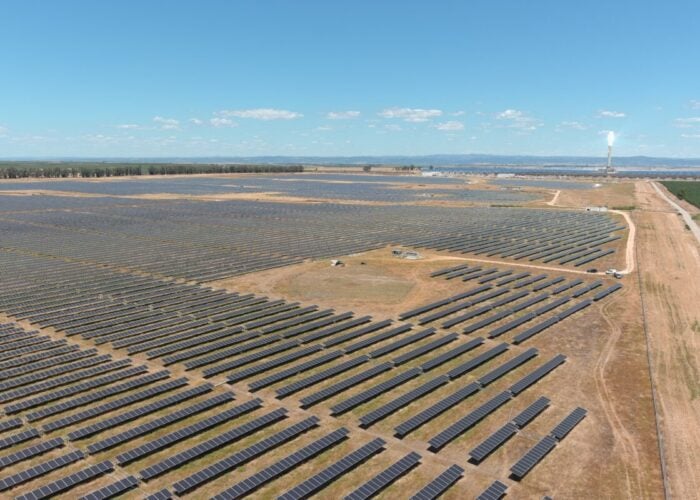
The world must get behind solar as a core engine of a global energy shift or risk failing in the delivery of the Paris Agreement on climate change, according to IRENA.
On Tuesday, the renewable energy body released new analysis showing installed solar capacity must balloon between 2018 (480GW), 2030 (2.84TW) and 2050 (8.519TW) if the planet is to have a chance to ward off the worst of catastrophic global warming.
Unlock unlimited access for 12 whole months of distinctive global analysis
Photovoltaics International is now included.
- Regular insight and analysis of the industry’s biggest developments
- In-depth interviews with the industry’s leading figures
- Unlimited digital access to the PV Tech Power journal catalogue
- Unlimited digital access to the Photovoltaics International journal catalogue
- Access to more than 1,000 technical papers
- Discounts on Solar Media’s portfolio of events, in-person and virtual
The document – published as the Sun World 2019 conference got underway in the Peruvian capital Lima – urged governments to bring down the policy, economic, regulatory and technological barriers stopping solar from achieving the proposed 18-fold boom by mid-century.
According to IRENA, reaching the 8.519TW-by-2050 mark will require the annual solar roll-out rates to speed up from 94GW in 2018 to 372GW per year by 2050. If achieved, the target would see solar generate 25% of the world’s energy by mid-century, overtaken only by wind power.
Building this global terawatt-scale solar fleet would be instrumental in the fight against climate change, IRENA said. Alone, the 8.519TW-by-2050 PV goal would see global CO2 emissions slashed by 4.9 gigatonnes by that year, a 22% share of the reductions the entire energy sector could achieve.
Asia leads while Latin America booms 40-fold
The colossal solar PV ecosystem IRENA wants to see by 2050 would remain dominated by Asia. Mainly led by China, the continent would become home to more than half of the 8.519TW market by that year, with North America accounting for 20% and Europe trailing far behind on 10%.
While not as sizeable in absolute terms, solar in Latin America and the Caribbean would, under IRENA’s projections, grow far faster than the worldwide average – the agency expects a 40-fold boom – by 2050. By that year, installed capacity in these regions could hit 280GW, from 7GW today.
“Projected [solar] growth rates in markets like Latin America showcase that we can extend the energy transition to all countries. It’s possible,” IRENA’s director-general Francesco La Camera remarked in a statement, published as the report was aired at the Lima conference.
The document analysed the state-of-play of the technologies powering the downstream solar boom. Aided by increasing uptake of PERC systems, the advent of bifacial cells and modules has been the “most important market shift” in cell architecture, IRENA estimated.
Its report mapped out the innovations set to further slash costs going forward, including efficiency milestones and the potential around tandem and perovskite applications. Circular approaches will be key if the industry is to manage the pile of components rising as roll-out surges, IRENA said.
Three-digit-billion-dollar splurge in PV, flexibility
IRENA’s solar roadmap – released just weeks before countries gather in Madrid for a fresh round of annual UN climate talks – acknowledged the transition to a terawatt-scale solar ecosystem will come with a significant price tag.
According to the document, annual investment in solar must jump 68% between 2018 (US$114 billion) and 2050 (US$192 billion). Asia’s dominance would see it hoard much of the annual funding needs (US$113 billion), followed by North America (US$37 billion) and Europe (US$19 billion).
Capital, the report said, must too flow towards grid upgrades, energy storage and others elements at an annual rate of US$374 billion if countries are to build enough flexibility, and successfully accommodate the influx of solar’s variable generation profile.
However, IRENA noted, the investment splurge could unlock socio-economic benefits for countries. From a global workforce of around 4.43 million in 2018, the industry could grow to employ 11.7 million by 2030 and about 18.7 million by 2050.
The prospects and challenges of solar's new era in Europe and beyond will take centre stage at Solar Media's Solar Finance & Investment Europe (London, 5-6 February) and Large Scale Solar Europe 2020 (Lisbon, on 31 March-1 April 2020).
The prospects and challenges of Latin American solar and storage will take centre stage at Solar Media's Energy Storage Latin America, to be held in Colombia on 28-29 April 2020.







